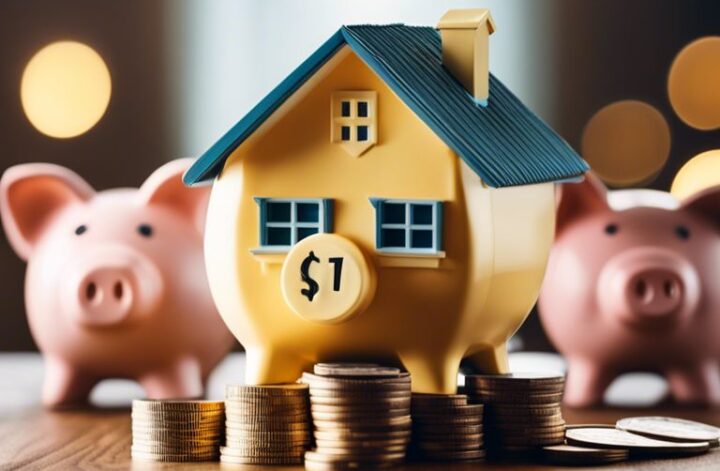Financial planning is crucial for young professionals looking to achieve the milestone of homeownership. One of the key steps in this journey is saving for a down payment, which can often be a significant hurdle for those entering the housing market. By implementing smart budgeting strategies and diligent saving habits, young professionals can make their dream of owning a home a reality.
Key Takeaways:
- Create a detailed budget: Start by tracking your expenses and income to identify areas where you can cut costs and allocate more money towards your down payment fund.
- Set a specific savings goal: Determine how much you need for a down payment and establish a timeline for reaching that goal, breaking it down into manageable monthly savings targets.
- Explore creative ways to save: Consider automating your savings, cutting back on discretionary spending, or finding additional sources of income to boost your down payment fund.
- Utilize homeownership programs: Research government programs, employer assistance, or first-time homebuyer programs that may offer down payment assistance or lower interest rates to help you achieve homeownership.
- Stay disciplined and be patient: Saving for a down payment takes time and commitment, so stay focused on your goal and resist the temptation to dip into your savings for non-necessary expenses.

Understanding Down Payments
There’s no denying that saving for a down payment can be a significant challenge for many young professionals. To help you navigate this process, check out How To Save For A Down Payment for some valuable tips and strategies.
What is a Down Payment?
With the goal of homeownership in mind, understanding what a down payment entails is crucial. A down payment is a lump sum of money that you pay upfront when purchasing a home. It typically ranges from 3% to 20% of the home’s purchase price, depending on the type of loan you qualify for. The larger the down payment you can afford, the lower your monthly mortgage payments and potentially the better interest rate you may secure.
How Much Should You Save?
On average, homebuyers should aim to save at least 20% of the home’s purchase price for a down payment. For example, if you’re looking to buy a $300,000 home, you should save around $60,000. However, some loan programs allow for down payments as low as 3%, so it’s imperative to explore all available options.
Another key aspect to consider is that having a larger down payment can also help you avoid paying private mortgage insurance (PMI), which is an additional cost added to your monthly mortgage payment to protect the lender in case you default on the loan. By saving more upfront, you can potentially save money in the long run by avoiding this extra expense.
Setting a Realistic Timeframe
Some young professionals may feel overwhelmed by the idea of saving for a down payment on a home. However, by breaking down the process into manageable steps and setting a realistic timeframe, homeownership can become an achievable goal.
Estimating Your Savings Goal
Estimating the amount you need to save for a down payment is a crucial first step in your homeownership journey. Typically, lenders require a down payment of around 20% of the home’s purchase price. For example, if you are looking to buy a $300,000 home, you would need to save $60,000 for the down payment.
Planning Your Homeownership Timeline
The key to successful budgeting for a home down payment is to set a clear timeline for achieving your savings goal. Consider factors such as your current income, monthly expenses, and any potential sources of additional income. By creating a timeline that aligns with your financial situation, you can establish a realistic path towards homeownership.
To ensure you stay on track with your savings goal, regularly review your progress and adjust your timeline as needed. Consistency and determination are key in making your dream of homeownership a reality.

Creating a Budget for Saving
Analyzing Current Expenses
Keep a close eye on your current expenses to understand where your money is going each month. This will help you identify any unnecessary spending and areas where you can cut back to save more for your down payment. Track your expenses for a few months to get a clear picture of your spending habits.
Identifying Areas to Reduce Spending
To successfully save for a down payment, it’s imperative to identify areas where you can reduce your spending. Look for discretionary expenses that can be cut back, such as dining out, entertainment, or subscriptions. By making small sacrifices in these areas, you can significantly increase your savings over time.
Another effective way to reduce spending is to negotiate with service providers for better rates or switch to cheaper alternatives. For example, consider cancelling unused gym memberships or exploring more affordable phone and internet plans. Every dollar saved adds up and brings you closer to reaching your homeownership goal.
Strategies to Accelerate Savings
Automating Your Savings
One of the most effective ways to accelerate your savings for a home down payment is by automating your savings. By setting up automatic transfers from your checking account to a dedicated savings account, you can ensure that a portion of your income goes towards your down payment fund every month. This hands-off approach makes it easier to consistently save without the temptation to spend the money elsewhere. For more tips on automating your savings, check out How to Boost Your Down Payment Fund for Your First Home.
High-Interest Savings Accounts and Investments
Savings accounts with high-interest rates can help accelerate the growth of your down payment fund. By depositing your savings in an account that offers a competitive interest rate, you can watch your money grow over time. Additionally, consider investing a portion of your savings in low-risk investment vehicles, such as mutual funds or index funds, to potentially earn higher returns on your money. Consult with a financial advisor to explore investment options that align with your timeline and risk tolerance.

Additional Sources of Income
For young professionals looking to save for a down payment on their first home, seeking out additional sources of income can significantly boost their savings potential. One popular way to increase income is through side hustles and part-time jobs.
Side Hustles and Part-Time Jobs
Income from side hustles and part-time jobs can provide a substantial financial boost towards your down payment goal. In fact, according to a survey, 45% of young professionals engage in side hustles to increase their income. Whether it’s freelancing, driving for a ride-sharing service, or working retail on weekends, these additional income streams can help you reach your homeownership aspirations faster.
Windfalls, Gifts, and Inheritance
Any unexpected windfalls, gifts, or inheritances can also be a significant help in saving for a down payment. In a study, 30% of homebuyers stated that they received financial assistance from family members towards their down payment. While it’s important to never rely solely on these sources, if you do happen to receive such a windfall, it can expedite your journey to homeownership.
Gifts from family members or loved ones can be a thoughtful way to help you achieve your goal of owning a home. If you have family members who are willing and able to gift you money towards your down payment, it can make a substantial difference in reaching your target amount sooner.
Government Programs and Incentives
Many government programs and incentives are available to help young professionals achieve their goal of homeownership by providing financial assistance and reducing the upfront costs associated with purchasing a home.
First-Time Home Buyer Programs
To support first-time home buyers, various government programs offer low-interest loans, grants, or assistance with down payments and closing costs. These programs aim to make homeownership more accessible and affordable for individuals who may not have the financial means to save for a large down payment on their own.
Tax Credits and Rebates
Rebates and tax credits can also help young professionals save money when buying a home. These incentives may include credits for first-time home buyers or rebates for energy-efficient upgrades made to the property. By taking advantage of these programs, individuals can reduce their overall housing costs and improve their financial stability as homeowners.
Maintaining Financial Health
To ensure you are on track to reach your goal of homeownership, it is crucial to maintain your financial health. This includes following a budget, tracking your expenses, and regularly saving for your down payment. For tips on how to save effectively, check out How to Save for a Down Payment – Money. Additionally, it is crucial to monitor your credit score and debt-to-income ratio to prepare for pre-approval and secure a mortgage with favorable terms.
Preparing for Pre-Approval and Mortgage
Health Maintaining good financial health and being prepared for pre-approval and securing a mortgage go hand in hand. Lenders will assess your financial situation, including your income, savings, and credit history, to determine your eligibility for a mortgage. By staying organized and demonstrating responsible financial habits, you can increase your chances of getting pre-approved and securing a mortgage at competitive rates.
Avoiding Common Financial Setbacks
To avoid common financial setbacks that can impede your progress towards homeownership, it is crucial to prioritize saving and budgeting. Unexpected expenses, impulse purchases, and lifestyle inflation can derail your savings goals. It is important to stick to your budget, avoid high-interest debt, and prioritize your down payment savings. By staying disciplined and focused on your goal, you can overcome potential obstacles and achieve homeownership sooner.
It is crucial to stay committed to your savings plan and make smart financial decisions along the way. By avoiding common financial pitfalls and staying disciplined in your approach, you can make your dream of owning a home a reality. Do not forget, every dollar saved brings you one step closer to achieving homeownership.
Conclusion
Conclusively, budgeting and saving for a home down payment is a crucial step towards achieving homeownership for young professionals. By implementing strategic financial strategies such as creating a budget, cutting back on expenses, increasing savings, and exploring alternative income sources, young professionals can make their dream of owning a home a reality. It requires discipline, determination, and careful planning, but with the right mindset and commitment, saving for a down payment can be attainable.
Homeownership is a significant milestone that provides stability, financial security, and a sense of pride for individuals. By setting realistic goals, closely monitoring expenses, and staying focused on the end goal, young professionals can move closer to purchasing their own home. With proper budgeting habits and a dedication to saving, homeownership can be within reach for those willing to put in the effort.




